Assessment of replacement cost of soil erosion in Uva high lands tea plantations of Sri Lanka
Prasad Dharmasena1 * and M.S. Bhat1
1
Department of Geography and Regional Development,
University of Kashmir,
Srinagar,
India
DOI: http://dx.doi.org/10.12944/CWE.6.2.05
The Uva High lands tea plantations in Sri Lanka represent intermediate zone on agroclimetic classification. This study was conducted to assess the runoff, soil loss and subsequent nutrient losses from Vegetative Propagation (VP) and Old Seedling Tea (OST) plantations of Passara region of Uva high lands in Sri Lanka. Four experimental soil erosion measurement units were installed 2 each for both land categories of 25 m length and 4 m width during 2010-2011 for one successive year, from these land uses were quantified the following standard methodologies. The annual runoff soil loss of old seedling tea fields were recorded as 25.52 tons/ha/yr and VP fields were calculated as 3.41 tons/ha/yr respectively of Uva regions in Sri Lanka. Loss of N was recorded as 29.34 and 4.80 kg/ha/yr from seedling and VP tea fields respectively. Loss of P of seedling tea field was observed as 2.10 and P from VP field was 0.92 kg/ha/yr. Loss of K was calculated as 182.4 kg/ha/yr of seedling field and K was assessed in VP as 13.6 kg/ha/yr. Total loss of organic matter was evaluated as 319.01 and 60.03 kg/ha/yr seedling and VP tea fields respectively. Subsequently, Total replacement (onsite) cost of one hectare seedling tea fields was recorded as Rs. 18011.45 and the replacement cost of VP field was Rs.8270.89 with the labor charges for spreading fertilizers and repairing and maintaining costs.
Copy the following to cite this article:
Dharmasena P, Bhat MS. Assessment of Replacement Cost of Soil Erosion in Uva High Lands Tea Plantations of Sri Lanka. Curr World Environ 2011;6:241-246 DOI:http://dx.doi.org/10.12944/CWE.6.2.05
Copy the following to cite this URL:
Dharmasena P, Bhat MS. Assessment of Replacement Cost of Soil Erosion in Uva High Lands Tea Plantations of Sri Lanka. Curr World Environ [serial online] 2011;6:241-246. Available from: http://www.cwejournal.org/?p=569
Download article (pdf)
Citation Manager
Publish History
Select type of program for download
| Endnote EndNote format (Mac & Win) | |
| Reference Manager Ris format (Win only) | |
| Procite Ris format (Win only) | |
| Medlars Format | |
| RefWorks Format RefWorks format (Mac & Win) | |
| BibTex Format BibTex format (Mac & Win) |
Article Publishing History
| Received: | 2011-11-12 |
|---|---|
| Accepted: | 2011-12-17 |
Introduction
Land degradations have been a major environmental issue in tea estates of Sri Lanka compared to rubber and coconut plantations. Nearly about 80% of the land is old seedling tea which is often poorly managed (Krishnaraja, 1983). Large tracts of these old seedling tea plantations have been either neglected or left for fallows. It is estimated that about 30% of the entire tea land is marginal or uneconomic in mid country. Long steeps and poor management practices are responsible for severe soil erosion on tea lands (Sivapanal.P, 1993).
Early plantations industry was under the management of British planters and there were no other parties in the industry with entitlement for the plantations. But tea industry of Sri Lanka today depends on three parties on management systems namely government tea estate, large scale private plantations and small holders. As this research concerned with large scale plantations where can be seen more seedling tea lands where is required as immediate rehabilitation and management. Seedlings tea lands of the large scale tea plantations (Special reference to the Regional Plantations Companies in Sri Lanka- RPCs) have two types of marginal lands on the definition of (Dharmasena, 2008). Those are Low productive lands, Zero productive lands. Well managed VP tea fields are ecologically and economically stabilized on records maintained by the respective plantations companies.
Study Area
Study sites are based in Passara tea growing region one of controversial region in environment management of the country, is rested in eastern slopes of the central mountain of the country. It is proved that more abandoned lands in Badulla tea region district are observed in Passara region compared with other tea growing areas of the district where boarded to two dry zone extremes.
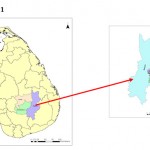 |
Map 1: Study Area Click here to View Map |
Methods and Materials
Four soil sedimentation plots were established in Passara of Sri Lanka in order to measure physical soil loss of two land use categories namely VP and seedling tea lands for the period of September 2010 - september2011. Two soil sedimentation plots were established in Dammeria A estate of Passara region and another two were established in Adawatte estate of Passara region. Average elevation of experimental block in Passara region is between 996m and 1120m. Soil of the site is Red Yellow Podzolic (RYP) in the experimental sites. The general elevation is laid between 889m and 1098m of these experimental sites. Slope gradient of both experimental sites are 20-30%. As more of mid country tea estates are placed between 20% and 30% land slope category (Central Environment Authority of Sri Lanka, 1998). Besides, steep slope lands are not allowed to be used for any development activity by the Central Environmental Authority and Tea Research Institute of Sri Lanka.
All these four experimental plots were designed along the line of the experiment carried out by Jinza (1981). He designed soil erosion sedimentation plots varying for 60m2 to 200m2. Even though, this particular experiment was based on sedimentation plots introduced by Jinza(1981), Size of sedimentation plot was standardized for 100m2 of 25m length and 4 m width in the area with a regular shape and sedimentation pit was 3m x 1.5m x 2m. Entire sedimentation plot was completely covered by using high gauge galvanize sheets for ensuring the prevention of over flowing run off or water going out from the plot. Runoff water from the sedimentation plot was collected in the sedimentation pits which have been well covered using white durable polytheene.
The sediments were dry after collecting of soil, if collecting period was rainy; until, it comes to normal moisture percentage and method is to weigh the sediment in the pit by using a commercial digital scale with acceptable accuracy; data also were collected once in two months. Deduct the moisture content to get the exact dry weight of moisture-free soil collected per pit, the results in the soil lost from 100m2 of area and is converted to determine the quantity lost from one hectare. Samples collected from each plot were tested in the laboratory to determine total loss of N, P, K and SOM….ect. The picture given below is an example of the experiment plots installed in Dammeria A estate of Passara tea region. Precipitation is measured by standard rain gauges of 200 mm tunnel diameter and recording gauges. The total amount of precipitation and the time of the start and end of each rainfall season are recorded. The distribution of precipitation with respect to time is observed mainly by recording gauges, and in places without such experimental facilities the time-dependency is obtained by taking manual readings at certain intervals.
The replacement method presumes that productivity declined is restored if lost nutrients and organic matter replace artificially (Sherman, 1994). Abegunawardena and Samarakoon 1994 have applied the same methods to estimate the onsite cost of soil erosion in Sri Lanka and Korean highland areas.
The replacement approach of soil erosion can be estimated by;
[latexpage]
\begin{equation} \label{eq:poly}
RC=\sum_{i=1}^{n}{RCi}
\end{equation}
\begin{equation} \label{eq:poly}
RC=(St-S_{(t+1)})\sum_{j=1}^{k}N_{ij}P_{j}+C_{il}+C{ir}
\end{equation} i=1….n, j=1….k
Where;
RCi is the replacement cost of nutrients loss in the i th category lands (Rs/ha)
St-S(t+1) is the soil loss from time t to t+1 (t/ha)
Nij is the quantity of j th nutrients in the i th land use type (Kg/ha)
Pj is the price of j th nutrient Rs/kg
Cil is the cost of labour charges for spreading fertilizer, (Rs/ha)
Cir is the cost of repair and maintenance damages of due to soil erosion (Rs/ha)
The replacement cost approach is able to furnish financial values for soil loss of different land use types in both places. Loss of NPK and organic matter were calculated using current prices. Normally tea plantations in Sri Lanka use Urea and rock Phosphate and Muriate of Potash fertilizers for replacing annual nutrients loss of tea field
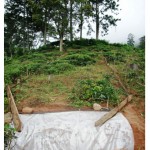 |
Figure 1 Click here to View figure |
Results and Discussion
Soil loss measurement plots systems were used to measure soil loss in Passara region for selected land used types. Normal agricultural practices have been carried out during also the experimental period. But
Applications of manure were closed before 6 months until experiments were completed, as it is required to ensure annual loss of NPK and organic carbon. The function of soil loss measurement unit was started in same date of the region.
All land use types could be selected in one division for installing soil loss measurement units as it was required to verify the degree of issue under the same independent variables. Below mention table elaborates the soil loss of 100m2 land area for the tested period.
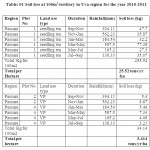 |
Table: 1 Soil loss at 100m2 territory in Uva region for the year 2010-2011 Click here to View table |
Soil nutrients loss is the major soil degradation issue in mountainous plantations. This hazard is occurred in due to soil degradation through soil erosion.
Soil nutrient depletion is a major concern in terms of resource utilization and optimization of production in the tea plantations. Soil and nutrient losses from plantation lands is responsible for pollution of surface waters and this reduces the productive capacity of land in direct and formation of unfavorable ecosystem is another issue related to plantation lands.
Parallel to soil loss measurements tests carried out in two estates of the Uva region, has been tested nutrients loss of different land uses systems. During the period of 2010 -2011, soil loss have been measured one time for a two months and it came total of six bulks for determination of total eroded extent during the tested period. Well mixed two representative samples were collected from the soil eroded pits and 12 samples were total. After testing these 12 samples to determine total nutrients loss, it was calculated average NPK percentages, pH texture and OM percentage during the period. The following table explains the nutrients content of silted soils of the pits of two lands uses of the region.
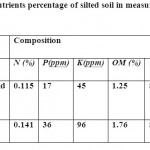 |
Table 2: Nutrients percentage of silted soil in measurement pits Click here to View table |
Above mentioned table shows average nutrients loss of different land use types. Soil tests were executed at six times in different 12 samples. Eventually average nutrients loss of 12 samples was calculated for representing annual loss of nutrients and finally current market prices were multiplied by total nutrients loss to determine the total annual onsite cost of VP and seedling tea fields in Uva region of Sri Lanka. Below mention tables illustrate the total nutrients loss in Sri Lankan rupees.
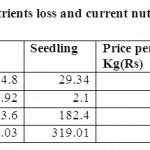 |
Table 3: Total Nutrients loss and current nutrients prices (Yr/Ha) Click here to View table |
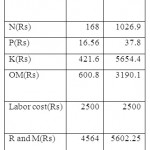 |
Table 4: Total Replacement cost for VP and Seedlings tea plantations (Yr/Ha) Click here to View table |
Conclusion and Recommendation
These figures illustrate that onsite cost and nutrients loss is very high in land use of seedling type tea plantations. Approximate seedling tea extent of the region is reported as 11000 in hectares (Statistics division, 2009). Total onsite cost of seedling tea fields of the region is as high as Rs: 198125950.00.
Vegetation cover is the ideal system for controlling the issue related tea garden of Uva region of Sri Lanka. It will also help to maintain good tea ecosystems of the region. Hence practicing of tree based mix cropping models in this region should be practiced as remedy for the issue in order to maintain stability and sustainability of tea ecosystem. Relevant authorities should take immediate action to re introduce biological soil conservations systems which have been practiced before privatization of the industry in Sri Lanka.
Acknowledgements
Authors are grateful to Mr. Jayampathy Molligoda Director of Bogawanthalawa Plantations Ltd and Mr.Nilan Liyanage Senior Superintendent of Telbedde Estate of Balangoda Plantations Ltd of Sri Lanka for their valuable contribution to the study. Authors are also thanking to all officials of Finlays’ Plantations PLC of Sri Lanka.
References
- Abeygunawardena, S. S. (1994). Economics of Upper Catchment Management for Irrigation Development:The case of Mahaweli Project In Sri Lanka. Proceedings of the First Annual General Meeting of Asian Society of Agricultural Economics .
- Central Environment Authority of Sri Lanka. (1998). Optimal land use in hill country of Sri Lanka. Colombo: CEA.
- Dharmasena, P. (2008). Agroforestry models to Improve economic viability of marginal tea lands. -: Unpublished.
- Krishnaraja, P. (1983). Soil loss and conservation planning in tea plantations in Sri Lanka. Natural system for development , 141-161.
- Ministry of Plantations Industries,Sri Lanka. (2009). Plantations sector statistical book. Colombo: Planning unit, Ministry of Plantations Industries.
- MOU, J. (1981). The establishment of experimental plots for studying runoff and soil loss in the rolling loess regions of China. Erosion and Sediment Transport Measurement (Proceedings of the Florence) (pp. 467-477). Zhengzhou,: IAHS Publishers.
- Punniyawardana, B. (2008). Rainfall and Agroecological Zones in Sri Lanka. Peradeniya: Agriculture Department of Sri Lanka.
- Sivapanal.P. (1993). Tea Industry in Sri Lanka. International Symposium on Tea Science and Human Health (pp. 77-85). Culculla-India: Tea Research Association.
- Statistics division. (2009). Tea statistics. Colombo: Sri Lanka Tea Board .






